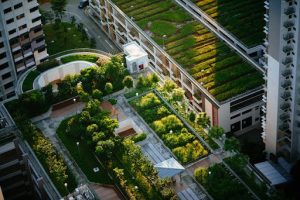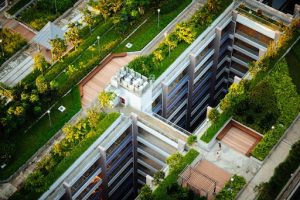Written By: Tvisha Lakhani
Edited By: Julia Georgescu
Designed By: Maahi Jain
Published By: Miriam Alonge Wato

What comes to your mind when you think of a city? Some might imagine a bustling, busy street, with sounds of people and vehicles constantly streaming through your ears. More still might imagine a maze of monotone skyscrapers reaching toward the skies. Whatever your vision, one thing that’s usually not associated with cities is greenery. Green roofs break down that traditional view of cities.
Green roofs in their most basic form are roofs that are covered in plant growth and vegetation. There are three main types: intensive, extensive, and semi-intensive. Extensive green roofs don’t have much irrigation and are shallower compared to their intensive counterparts. As a result, heavier plants and trees can only be planted on intensive roofs, which have a more complex structure. Extensive green roofs are much lighter and lower in cost. Semi-intensive green roofs are a middle ground between the intensive and extensive. Some benefits of green roofs are obvious, such as how they can improve air quality by reducing CO2. Green roofs also have many more advantages. They’re great to install because of their role in decreasing the Urban Heat Island effect, their contribution to the reduction of runoff, and economic benefits.
Green roofs reduce the Urban Heat Island effect, an occurrence in which city surfaces such as pavement and buildings absorb heat, making the city warmer than its surrounding areas. The Heat Island effect is decreased through a process called evapotranspiration, where water from the soil evaporates and water from a plant’s leaves transpires into the air. Green roofs, for this reason, are ideal for city rooftops.
 Green roofs can also reduce runoff. Runoff is any water that cannot be soaked up into the ground and ‘runs off’ the land into bodies of water. In an urban area, it is estimated that 55% of all rainfall is runoff, compared to only 10% in rural areas. Urban runoff is harmful for the environment because it can carry pollutants from cities into bodies of water. Cities have a higher amount of runoff because they are mostly covered in surfaces such as roads that don’t allow water to seep into the ground. In a rural area, 50% of all rain is infiltrated into the ground, while only about 15% infiltrates the ground in a city. Green roofs can naturally hold water and thereby reduce runoff. Additionally, green roofs filter the stormwater they soak up. It is estimated that they filter out about 60-90% of cadmium, copper and lead present in rainwater. Therefore, green roofs can be used as an integral component in a city’s runoff reduction strategy.
Green roofs can also reduce runoff. Runoff is any water that cannot be soaked up into the ground and ‘runs off’ the land into bodies of water. In an urban area, it is estimated that 55% of all rainfall is runoff, compared to only 10% in rural areas. Urban runoff is harmful for the environment because it can carry pollutants from cities into bodies of water. Cities have a higher amount of runoff because they are mostly covered in surfaces such as roads that don’t allow water to seep into the ground. In a rural area, 50% of all rain is infiltrated into the ground, while only about 15% infiltrates the ground in a city. Green roofs can naturally hold water and thereby reduce runoff. Additionally, green roofs filter the stormwater they soak up. It is estimated that they filter out about 60-90% of cadmium, copper and lead present in rainwater. Therefore, green roofs can be used as an integral component in a city’s runoff reduction strategy.
Green roofs aren’t just good for the environment, though; they can help save money too! Green roofs provide an extra layer of insulation in a building, so less heat escapes during winter time, whereas less cool air escapes during summer time. This results in a lower use of air-conditioning and heating, and consequently a lower energy bill. The installed green roof will also outlast a regular roof. Furthermore, the green roof can have recreational uses. Many intensive green roofs are operated as parks. Overall, green roofs can save large amounts of money and energy over time.

In conclusion, green roofs have many benefits, including but certainly not limited to the reduction of the Urban Heat Island Effect, a decrease in runoff, and lower energy bills. While they may be a heavy investment initially, the benefits of green roofs make it worth it.
Works Cited
About Green Roofs. (n.d.). Green Roofs for Healthy Cities. https://greenroofs.org/about-green-roofs
CHUTTERSNAP. (2018). top view of building with trees photo [Photograph]. Unsplash. https://unsplash.com/photos/IfmqOuOkaOA
CHUTTERSNAP. (2018). building scale model photo [Photograph]. Unsplash. https://unsplash.com/photos/nXJyZLBnyUQ
Dowdey, S. (2007, July 11). What is a Green Roof? HowStuffWorks. https://science.howstuffworks.com/environmental/green-science/green-rooftop.htm
Green Roofs. (n.d.). Green Infrastructure Ontario. https://greeninfrastructureontario.org/green-roof/
Learn About Heat Islands. (2022, September 2). United States Environmental Protection Agency. https://www.epa.gov/heatislands/learn-about-heat-islands
Office of Air and Radiation. (2009, February 9). Heat Island Effect Glossary. United States Environmental Protection Agency. https://sor.epa.gov/sor_internet/registry/termreg/searchandretrieve/glossariesandkeywordlists/search.do;jsessionid=MJvd58VzOSMz9kweUhct-d0jfx3qJI46vk-rAXGxNdWKrWRD02rJ!1782426630?details=&vocabName=Heat%20Island%20Effect%20Glossary&filterTerm=evapotranspiration&checkedAcronym=false&checkedTerm=false&hasDefinitions=false&filterTerm=evapotranspiration&filterMatchCriteria=Contains
Protecting Water Quality from Urban Runoff. (2003, February). United States Environmental Protection Agency. https://www3.epa.gov/npdes/pubs/nps_urban-facts_final.pdf
Reduce Urban Heat Island Effect. (2023, March 6). United States Environmental Protection Agency. https://www.epa.gov/green-infrastructure/reduce-urban-heat-island-effect
Rutledge, K., McDaniel, M., Teng, S., Hall, H., Ramroop, T., Sprout, E., Hunt, J., Boudreau, D., & Costa, H. (2022, October 21). Runoff. National Geographic. https://education.nationalgeographic.org/resource/runoff/
Soak Up the Rain: Green Roofs. (2023, March 24). United States Environmental Protection Agency. https://www.epa.gov/soakuptherain/soak-rain-green-roofs
Talmacs, I. (2022). water pouring from a pipe into a pipe photo [Photograph]. Unsplash. https://unsplash.com/photos/4CWThJ_srvQ
TEDx Talks, & Legerton, H. (2014, May 15). Your roof and the environment–why green is the new black: Hunter Legerton at TEDxCharleston [Video]. YouTube. https://www.youtube.com/watch?v=22NIzIdJHbk
Using Green Roofs to Reduce Heat Islands. (2022, July 13). United States Environmental Protection Agency. https://www.epa.gov/heatislands/using-green-roofs-reduce-heat-islands

